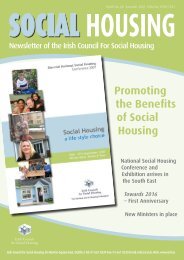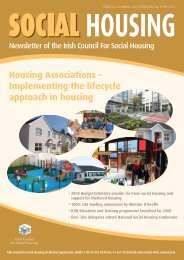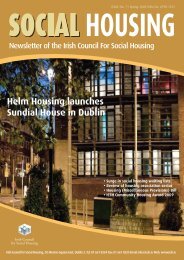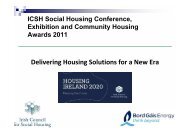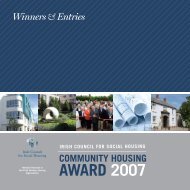National Housing Strategy for People with a Disability 2011 - 2016
National Housing Strategy for People with a Disability 2011 - 2016
National Housing Strategy for People with a Disability 2011 - 2016
Create successful ePaper yourself
Turn your PDF publications into a flip-book with our unique Google optimized e-Paper software.
5.30 <strong>Housing</strong> associations providing care and health related support services <strong>for</strong> theirtenants in different models of housing can apply <strong>for</strong> funding from the HSE <strong>for</strong> the healthrelated elements of the service. Section 39 funding under the Health Act 2004 is on thebasis of the provision of health and personal care supports which are ancillary to a servicethe HSE may provide. This funding can provide a variety of services and support to tenantssuch as meals on wheels and care staff. A need <strong>for</strong> greater coordination between capitaland current funding <strong>for</strong> CAS projects, where ongoing support costs are required, wasidentified as a challenge <strong>for</strong> this sector. In order to address this issue, DECLG, inpartnership <strong>with</strong> the Department of Health, local authorities, HSE and ICSH has developedan interagency protocol to facilitate the better coordination of capital and revenue funding<strong>for</strong> health service related support costs <strong>for</strong> such projects. This protocol, which wasimplemented in March <strong>2011</strong>, will assist housing associations by ensuring that there isapproval in principle <strong>for</strong> the appropriate health service related revenue funding from theHSE, as new schemes are dependent on approval <strong>for</strong> appropriate revenue streams at theoutset.5.31 A strategic review of the capital funding schemes <strong>for</strong> voluntary and co-operativehousing was launched in September 2009. The review endorsed the positive impact of CASin meeting housing needs <strong>for</strong> people <strong>with</strong> specific needs and recommends its retention asan instrument <strong>for</strong> targeting capital investment towards meeting the housing needs of olderpeople, those <strong>with</strong> disabilities and <strong>for</strong>merly homeless people.5.32 An enhanced programme of housing <strong>for</strong> homeless people was available in 2010 toprocure additional accommodation <strong>for</strong> homeless households by approved housing bodies,working <strong>with</strong> the Department and the local authority. A key element of the enhancedfinancial package was the allocation of €20 million in capital funding. This was available, inconjunction <strong>with</strong> funding under the social housing leasing initiative, to leverage theprocurement of the maximum number of properties either through leasing or purchaseusing private funding or, borrowing from the <strong>Housing</strong> Finance Agency. Tenancy supportservice would be available, as necessary, in accordance <strong>with</strong> the Slí (Support to LiveIndependently) initiative. Delivery on the enhanced programme <strong>for</strong> procuringaccommodation was determined primarily by action on the part of housing authorities andapproved housing bodies and the response of market interests, including property ownersand financial institutions. There was a poor response to the enhanced leasing programmewhich was, there<strong>for</strong>e, discontinued.5.33 Given the key role of the voluntary housing sector in meeting the accommodationneeds of people <strong>with</strong> specific needs, it is recommended that the development proposals ofapproved housing bodies should reflect and be aligned to relevant future local authorityhousing services plans, to facilitate better planning.57



